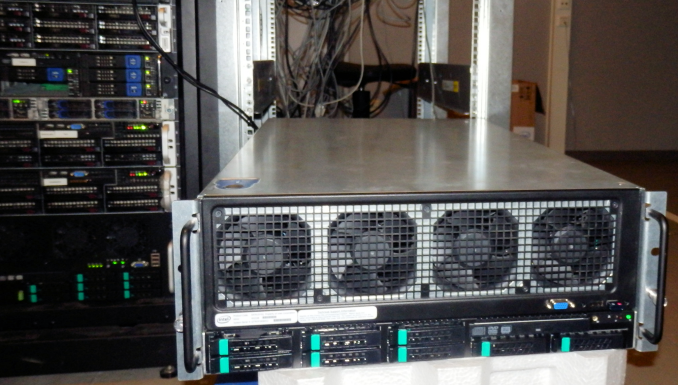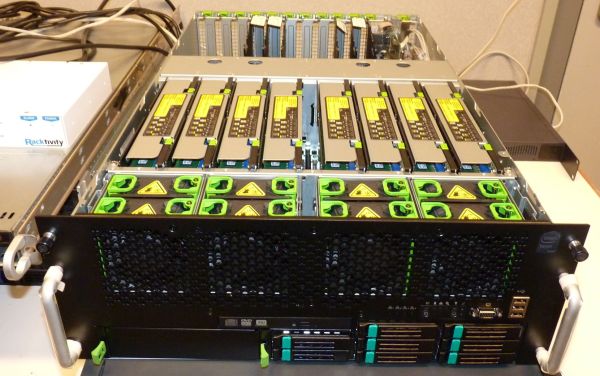The Intel Xeon E7-8800 v3 Review: The POWER8 Killer?
by Johan De Gelas on May 8, 2015 8:00 AM EST- Posted in
- CPUs
- IT Computing
- Intel
- Xeon
- Haswell
- Enterprise
- server
- Enterprise CPUs
- POWER
- POWER8
Benchmark Configuration
As far as reliability is concerned, while we little reason to doubt that the quad Xeon OEM systems out there are the pinnacle of reliability, our initial experience with Xeon E7 v3 has not been as rosy. Our updated and upgraded Quad Xeon Brickland system was only finally stable after many firmware updates, with its issues sorted out just a few hours before the launch of the Xeon E7 v3. Unfortunately this means our time testing the stable Xeon E7 v3 was a bit more limited than we would have liked.
Meanwhile to make the comparison more interesting, we decided to include both the Quad Xeon "Westmere-EX" as well as the "Nehalem-EX". Remember these heavy duty, high RAS servers continue to be used for much longer in the data center than their dual socket counterparts, 5 years or more are no exception. Of course, the comparison would not be complete without the latest dual Xeon 2699 v3 server.
All testing has been done on 64 bit Ubuntu Linux 14.04 (kernel 3.13.0-51, gcc version 4.8.2).
Intel S4TR1SY3Q "Brickland" IVT-EX 4U-server
The latest and greatest from Intel consists of the following components:
| CPU | 4x Xeon E7-8890v3 2.5 GHz 18c, 45 MB L3, 165W TDP or 4x Xeon E7-4890 v2 (D1 stepping) 2.8GHz 15 cores, 37.5MB L3, 155W TDP |
| RAM | 256 GB, 32x 8 GB Micron DDR-4-2100 at 1600MHz or 256 GB, 32x8GB Samsung 8GB DDR3 M393B1K70DH0-YK0 at 1333MHz |
| Motherboard | Intel CRB Baseboard "Thunder Ridge" |
| Chipset | Intel C602J |
| PSU | 2x1200W (2+0) |
Total amount of DIMM slots is 96. When using 64GB LRDIMMs, this server can offer up to 6TB of RAM.
If only two cores are active, the 8890 can boost the clockspeed to 3.3 GHz (AVX code: 3.2 GHz). The 4890v2 reaches 3.4 GHz in that situation. Even with all cores active, 2.9 GHz is possible (AVX code: 2.6 GHz).
Intel Quanta QSCC-4R Benchmark Configuration
The previous quad Xeon E7 server, as reviewed here.
| CPU | 4x Xeon X7560 at 2.26GHz, or 4x Xeon E7-4870 at 2.4GHz |
| RAM | 16x8GB Samsung 8GB DDR3 M393B1K70DH0-YK0 at 1066MHz |
| Motherboard | QCI QSSC-S4R 31S4RMB00B0 |
| Chipset | Intel 7500 |
| BIOS version | QSSC-S4R.QCI.01.00.S012,031420111618 |
| PSU | 4x850W Delta DPS-850FB A S3F E62433-004 850W |
The server can accept up to 64 32GB Load Reduced DIMMs (LR-DIMMs) or 2TB.
Intel's Xeon E5 Server – "Wildcat Pass" (2U Chassis)
Finally, we have our Xeon E5 v3 server:
| CPU | Two Intel Xeon processor E5-2699 v3 (2.3GHz, 18c, 45MB L3, 145W) |
| RAM | 128GB (8x16GB) Samsung M393A2G40DB0 (RDIMM) |
| Internal Disks | 2x Intel MLC SSD710 200GB |
| Motherboard | Intel Server Board Wilcat pass |
| Chipset | Intel Wellsburg B0 |
| BIOS version | August the 9th, 2014 |
| PSU | Delta Electronics 750W DPS-750XB A (80+ Platinum) |
Every server was outfitted with two 200 GB S3700 SSDs.












146 Comments
View All Comments
DanNeely - Friday, May 8, 2015 - link
Intel's 94% market share is still only ~184k systems. That's tiny compared to the mainstream x86 market; and doesn't give a lot of (budgetary) room to make radical changes to CPU vs just scaling shared designs to a huger layout.theeldest - Friday, May 8, 2015 - link
184k for 4S systems. The number of 2S systems *greatly* outnumbers the 184k.Samus - Sunday, May 10, 2015 - link
by 100 orders of magnitude, easily.2S systems are everywhere these days, I picked up a Lenovo 2S Xeon system for $600 NEW (driveless, 4GB RAM) from CDW.
4S, on the other hand, is considerably more rare and starts at many thousands, even with 1 CPU included.
erple2 - Sunday, May 10, 2015 - link
Well, maybe 2 orders of magnitude. 100 orders of magnitude would imply, based on the 184k 4S systems, more 2S systems than atoms in the universe. Ok, I made that up, I don't know how many atoms are in the universe, but 10^100 is a really big number. Well, 10^105, if we assume 184k 4S systems.I think you meant 2 orders of magnitude.
mapesdhs - Sunday, May 10, 2015 - link
Yeah, that made me smile too, but we know what he meant. ;)evolucion8 - Monday, May 11, 2015 - link
That would be right if Intel cores are wide enough which aren't compared to IBM. For example, according to this review, enabling two way SMT boosted the performace to 45% and adding two more threads added 30% more performance. On the other hand, enabling two way SMT on the latest i7 architecture can only go up to 30% on the best case scenario.chris471 - Friday, May 8, 2015 - link
Great article, and I'm looking forward to see more Power systems.I would have loved to see additional benchmarks with gcc flags -march=native -Ofast. Should not change stream triad results, but I think 7zip might profit more on Power than on Xeon. Most software is not affected by the implied -ffast-math.
close - Friday, May 8, 2015 - link
It reminds me of the time when Apple gave up on PowerPC in mobiles because the new G5s were absolute power guzzlers and made space heaters jealous. And then gave up completely and switched to Intel because the 2 dual core PowerPC 970MP CPUs at 2.5GHz managed to pull 250W of power and needed liquid cooling to be manageable.IBM is learning nothing from past mistakes. They couldn't adapt to what the market wanted and the more nimble competition was delivering 25-30 years ago when fighting Microsoft, it already lost business to Intel (which is actually only nimble by comparison), and it's still doing business and building hardware like we're back in the '70s mainframe age.
name99 - Friday, May 8, 2015 - link
You are assuming that the markets IBM sells into care about the things you appear to care about (in particular CPU performance per watt). This is a VERY dubious assumption.The HPC users MAY care (but I'd need to see evidence of that). For the business users, the cost of the software running on these systems dwarfs the lifetime cost of their electricity.
SuperVeloce - Saturday, May 9, 2015 - link
They surely care. Why wouldn't they. A whole server rack or many of them in fact do use quite a bit of power. And cooling the server room is very expensive.